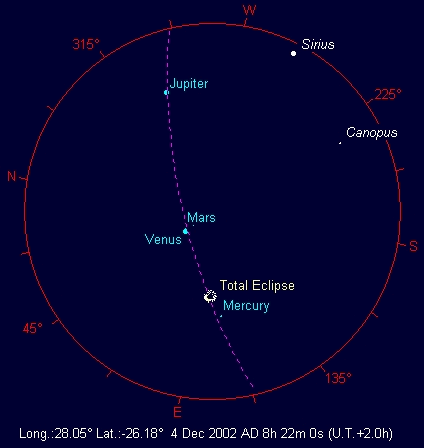
| HartRAO Home | Eclipse Home | Eclipse Next | Eclipse Previous |

At totality in South Africa, we will be looking at the eclipsed Sun. This will be located 10 degrees south of due east, and at 42 degrees above the horizon. This is shown in the skychart above, made with the free astronomy program "Starcalc" (and a little editing). To orient it, hold it over your head, and face 10 degrees south of east. The horizon is shown by the red circle. The dashed line shows the ecliptic, the path of the Sun across the sky.
Apart from the eclipsed Sun, what else could we see in the sky with the unaided eye?
The planet Venus will be easily visible, just 15 degrees to the northeast of the zenith (the point directly overhead). The "red" planet, Mars, will be very close to Venus, but quite likely too faint to be seen. The planet Jupiter, low in the north west, should be visible. The little planet Mercury, 10 degrees below the Sun, will also probably be too faint to see.
The two brightest stars in the sky, Sirius and Canopus, will be in the sky but close to the horizon. The "sunset" that we will see all around the horizon will probably hide them. Not shown but possibly visible if it is extremely dark is the star Alpha Centauri, the brighter of the "pointers" pointing at the Southern Cross. This would be seen to the south.